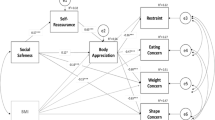Abstract
Objective: Secrecy and concealment are typical behaviours in individuals with eating problems. This study explored the relationship between eating-related problems and selfdisclosure. It examined whether women with greater eating related problems were less willing to disclose. Different types of self-disclosure were calculated, considering disclosure related to body appearance and to restrained eating. The role of risk factors which concur to the development and maintenance of eating symptomatology was also explored. Method: The Eating Symptoms Inventory was used to investigate the existence of an eventual eating symptomatology, self-disclosure was calculated through the Self-Disclosure Index, while a new scale was validated to assess a self-disclosure related to body image and eating attitudes. Other scales measured the influence of different risk factors, as body dissatisfaction, social pressure to be thin, and restrained eating. Results: A significant inverse relationship was found between general self-disclosure and psychological aspects related to the practice of wrong weight control behaviours and risk factors as dieting, body dissatisfaction, and social pressure to be thin. The significant role of risk factors was confirmed in the development and maintenance of eating disturbances. Interesting results were found using the different self-disclosure indexes as mediators and moderators. Relevant differences were found between Dutch and Italians concerning to their eating attitudes and to the role of different risk factors. Conclusion: Some limits are the impossibility to generalize these findings and the use of a non clinical sample. Some new longitudinal studies should be done in this direction to deepen the relationship between self-disclosure and eating disorders.
Similar content being viewed by others
References
Shaw B.F., Garfinkel B.F.: Research problems in eating disorders. Int. J. Eat. Disord., 9, 545–555, 1990.
Derlega V.J., Metts S., Petronio S., Margulis S.: Self-disclosure. Newbury park, CA. Sage, 1993.
Pennebaker, J.W.: Writing about emotional experiences as a therapeutic process. Psycholo. Sci., 8, 131–147, 1997a.
Pennebaker, J.W.: Confession, inhibition and disease. Adv. Exp. Soc. Psychol., 22, 211–242, 1989.
Sanftner J.L., Barlow D.H., Marschale D.E., Tangney J.P.: The relation of shame and guilt to eating disorder symptomatology. J. Soc. Clin. Psychol., 14, 315–324, 1995.
Silberstein L.R., Striegel-Moore R.H., Rodin J.: Talking fat: A woman’s shame. In: Leivis, Halen. Block (Eds.), Hillsdale, NY, Lawrence Erlbaum Associates, 1987.
Abraham S., Llewellyn J.D.: Eating disorders: The fact. 3rd ed., New York, Oxford University Press, 1992.
Le Grange D., Tibbs J., Selibowitz, J.: Eating attitudes, body shape, and self-disclosure in a community sample of adolescent girls and boys. J. Treatment and Prevention, 3, 253–264, 1995.
Evans L., Wertheir E.H.: An examination of willingness to self-disclose in women with bulimic symptoms considering the context of disclosure and negative affect levels. Int. J. Eat. Disord., 31, 344–348, 2002.
Smart L., Wegner D.M.: Covering what can’t be seen: Cancelable stigma and mental control. J. Person. Soc. Psychol., 77, 474–486, 1999.
Gross J.J., Levenson R.W.: Hiding feelings: The acute effects of inhibiting negative and positive emotion. J. Abnorm. Psychol., 1, 95–103, 1997.
Stunkard A.J., Albaum J.: The accuracy of self-reported weights. Am. J. Clin. Psychol., 61, 296–305, 1981.
Whitaker A., Davies M., Shaffer D., Johnson J., Abrams S., Walsh B.T., Kalikow K.: The struggle to be thin: a survey of anorexic and bulimic symptoms in a non-referred adolescent population. Psychol. Med., 19, 143–163, 1989.
Miller L.C., Berg J.H., Archer R.L.: Openers: individuals who elicit intimate self-disclosure, J. Person. Soc. Psychol., 44, 1234–1244, 1983.
Garner D.M., Olmstead M.P., Polivy, J.: Development and validation of multidimensional eating disorder inventory for anorexia nervosa and bulimia. Int. J. Eat. Disord., 2, 15–34, 1983.
Van Strien T., Frijters J.E.R., Bergers G.P.A., Defares P.B.: The Dutch eating behavior questionnaire for assessment of restrained emotional, and external eating behavior. Int. J. Eat. Disord., 5, 295–315, 1986.
Favaro A., Ferrare S., Santonastaso P.: The spectrum of eating disoders in young women: a prevalence study in a general population sample. Psychosom. Med., 65, 701–708, 2003.
Bijl R.V., Ravelli A., van Zessen G.: Prevalence of psychiatric disorder in the general population: results of the Netherlands Mental Health Survey and Incidence Study (NEMESIS). Soc. Psychiatr. Epidemiol., 33, 587–595, 1998.
Ruggiero G.M., Wolfgang H., Mantero M., Papa R.: Body acceptance and culture: a study in Northern and Southern Ialy. Eur. Eat. Disord. Rev., 8, 40–50, 2000.
Author information
Authors and Affiliations
Corresponding author
Rights and permissions
About this article
Cite this article
Basile, B. Self-disclosure in eating disorders. Eat Weight Disord 9, 217–223 (2004). https://doi.org/10.1007/BF03325070
Published:
Issue Date:
DOI: https://doi.org/10.1007/BF03325070



